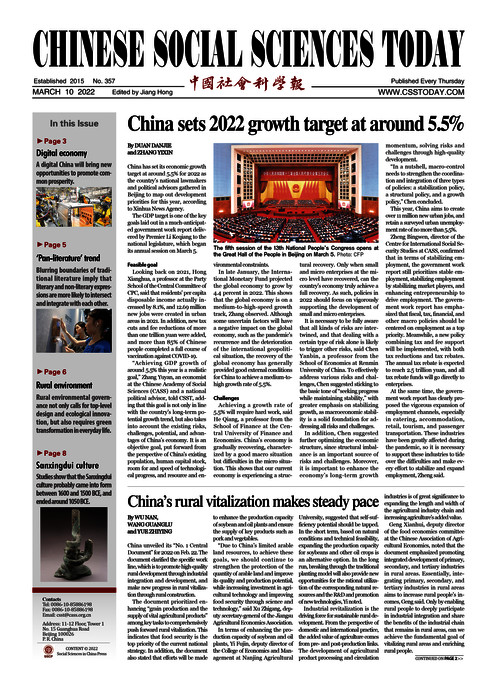China’s rural vitalization makes steady pace
2022-03-10 14:30:23
By WU NAN,
WANG GUANGLU
and YUE ZHIYING
China unveiled its “No. 1 Central Document” for 2022 on Feb. 22. The document clarified the specific work line, which is to promote high-quality rural development through industrial integration and development, and make new progress in rural vitalization through rural construction.
The document prioritized enhancing “grain production and the supply of vital agricultural products” among key tasks to comprehensively push forward rural vitalization. This indicates that food security is the top priority of the current national strategy. In addition, the document also stated that efforts will be made to enhance the production capacity of soybean and oil plants and ensure the supply of key products such as pork and vegetables.
“Due to China’s limited arable land resources, to achieve these goals, we should continue to strengthen the protection of the quantity of arable land and improve its quality and production potential, while increasing investment in agricultural technology and improving food security through science and technology,” said Xu Zhigang, deputy secretary-general of the Jiangsu Agricultural Economics Association.
In terms of enhancing the production capacity of soybean and oil plants, Yi Fujin, deputy director of the College of Economics and Management at Nanjing Agricultural University, suggested that self-sufficiency potential should be tapped. In the short term, based on natural conditions and technical feasibility, expanding the production capacity for soybeans and other oil crops is an alternative option. In the long run, breaking through the traditional planting model will also provide new opportunities for the rational utilization of the corresponding natural resources and the R&D and promotion of new technologies, Yi noted.
Industrial revitalization is the driving force for sustainable rural development. From the perspective of domestic and international practice, the added value of agriculture comes from pre- and post-production links. The development of agricultural product processing and circulation industries is of great significance to expanding the length and width of the agricultural industry chain and increasing agriculture’s added value.
Geng Xianhui, deputy director of the food economics committee at the Chinese Association of Agricultural Economics, noted that the document emphasized promoting integrated development of primary, secondary, and tertiary industries in rural areas. Essentially, integrating primary, secondary, and tertiary industries in rural areas aims to increase rural people’s incomes, Geng said. Only by enabling rural people to deeply participate in industrial integration and share the benefits of the industrial chain that remains in rural areas, can we achieve the fundamental goal of vitalizing rural areas and enriching rural people.
Geng said that the circulation system is not only a production and sales platform, but also a huge engine that leads production and consumption upgrades. The development of rural industries, especially the integrated development of primary, secondary, and tertiary industries in rural areas, must prioritize the construction of a modern agricultural product circulation system. It is important to accelerate the construction of agricultural product processing centers, cold chain and fresh logistics centers, agricultural product processing and distribution centers, and new marketing centers for agricultural products.
The high-quality development of rural industries is inseparable from the input of modern resources and factors of production, such as talent, technology, capital, land, management, and data. Talent, in particular, has become an important resource driving the high-quality development of rural industries. Geng suggested establishing a talent incentive mechanism involving policy support, financial loans, tax incentives, and entrepreneurial funds, to support and encourage talent to return to rural areas.



